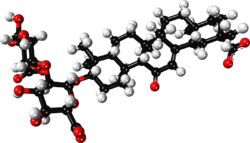Chemistry:Glycyrrhizin
 | |
 | |
| Clinical data | |
|---|---|
| Trade names | Epigen, Glycyron |
| AHFS/Drugs.com | International Drug Names |
| Routes of administration | Oral, intravenous |
| ATC code | |
| Pharmacokinetic data | |
| Metabolism | Hepatic and by intestinal bacteria |
| Elimination half-life | 6.2–10.2 hours[1] |
| Excretion | Faeces, urine (0.31–0.67%)[2] |
| Identifiers | |
| |
| CAS Number |
|
| PubChem CID | |
| ChemSpider | |
| UNII | |
| KEGG | |
| ChEBI | |
| ChEMBL | |
| Chemical and physical data | |
| Formula | C42H62O16 |
| Molar mass | 822.942 g·mol−1 |
| 3D model (JSmol) | |
| Solubility in water | 1–10 mg/mL (20 °C) |
| |
| |
Glycyrrhizin (glycyrrhizic acid or glycyrrhizinic acid) is the chief sweet-tasting constituent of Glycyrrhiza glabra (liquorice) root. Structurally, it is a saponin used as an emulsifier and gel-forming agent in foodstuffs and cosmetics. Its aglycone is enoxolone.
Pharmacokinetics
After oral ingestion, glycyrrhizin is hydrolysed to 18β-glycyrrhetinic acid (enoxolone) by intestinal bacteria. After absorption from the gut, 18β-glycyrrhetinic acid is metabolised to 3β-monoglucuronyl-18β-glycyrrhetinic acid in the liver. This metabolite circulates in the bloodstream. Consequently, its oral bioavailability is poor.[quantify] Most of it is eliminated by bile and only a minor part (0.31–0.67%) by urine.[3] After oral ingestion of 600 mg of glycyrrhizin the metabolite appeared in urine after 1.5 to 14 hours. Maximal concentrations (0.49 to 2.69 mg/L) were achieved after 1.5 to 39 hours and metabolite can be detected in the urine after 2 to 4 days.[3]
Flavouring properties
Glycyrrhizin is obtained as an extract from licorice root after maceration and boiling in water.[4] Licorice extract (glycyrrhizin) is sold in the United States as a liquid, paste, or spray-dried powder.[4] When in specified amounts, it is approved for use as a flavor and aroma in manufactured foods, beverages, candies, dietary supplements, and seasonings.[4] It is 30 to 50 times as sweet as sucrose (table sugar).[5]
Adverse effects
The most widely reported side effect of glycyrrhizin use via consumption of black liquorice is reduction of blood potassium levels, which can affect body fluid balance and function of nerves.[6][7] Chronic consumption of black licorice, even in moderate amounts, is associated with an increase in blood pressure,[7] may cause irregular heart rhythm, and may have adverse interactions with prescription drugs.[6] In extreme cases, death can occur as a result of excess consumption.[8][9]
See also
- 11α-Hydroxyprogesterone
- Glycyrrhetinic acid
- List of unusual deaths
References
- ↑ "Pharmacokinetics of intravenous glycyrrhizin after single and multiple doses in patients with chronic hepatitis C infection". Clinical Therapeutics 21 (12): 2080–2090. December 1999. doi:10.1016/S0149-2918(00)87239-2. PMID 10645755. https://pure.eur.nl/en/publications/25e2d17a-3123-40f6-9b23-2ca4ddbc0c97.
- ↑ "The pharmacokinetics of glycyrrhizic acid evaluated by physiologically based pharmacokinetic modeling". Drug Metabolism Reviews 33 (2): 125–147. May 2001. doi:10.1081/DMR-100104400. PMID 11495500.
- ↑ 3.0 3.1 "Excretion profile of glycyrrhizin metabolite in human urine". Food Chemistry 131: 305–308. 2012. doi:10.1016/j.foodchem.2011.08.081.
- ↑ 4.0 4.1 4.2 "Sec. 184.1408 Licorice and licorice derivatives". US Food and Drug Administration, Code of Federal Regulations Title 21, 21CFR184.1408. 1 April 2017. https://www.accessdata.fda.gov/scripts/cdrh/cfdocs/cfcfr/CFRSearch.cfm?fr=184.1408.
- ↑ "Glycyrrhizic Acid". PubChem. National Institutes of Health. https://pubchem.ncbi.nlm.nih.gov/summary/summary.cgi?cid=14982.
- ↑ 6.0 6.1 "Black Licorice: Trick or Treat?". US Food and Drug Administration. 30 October 2017. https://www.fda.gov/ForConsumers/ConsumerUpdates/ucm277152.htm.
- ↑ 7.0 7.1 "The association between consistent licorice ingestion, hypertension and hypokalaemia: a systematic review and meta-analysis". Journal of Human Hypertension 31 (11): 699–707. November 2017. doi:10.1038/jhh.2017.45. PMID 28660884.
- ↑ "Too much candy: Man dies from eating bags of black licorice". AP News. https://apnews.com/04cf918055b735ea69483dd00e281253.
- ↑ "Case 30-2020: A 54-Year-Old Man with Sudden Cardiac Arrest". The New England Journal of Medicine 383 (13): 1263–1275. September 2020. doi:10.1056/NEJMcpc2002420. PMID 32966726.
External links
 |

